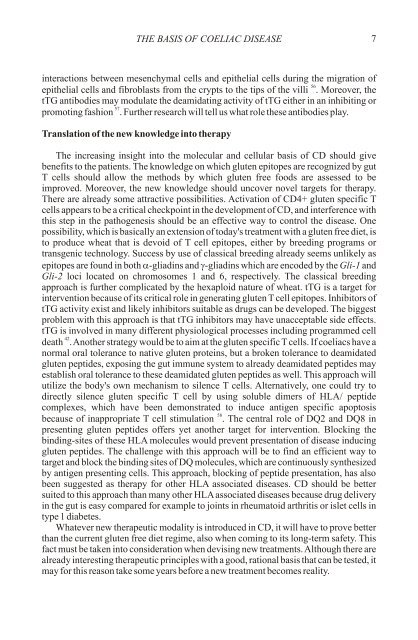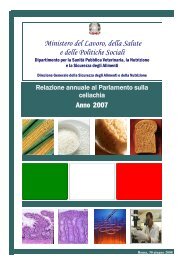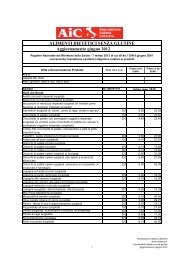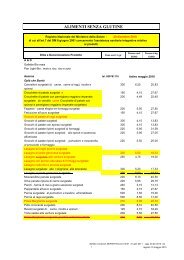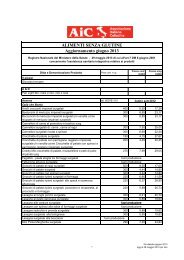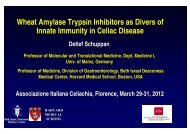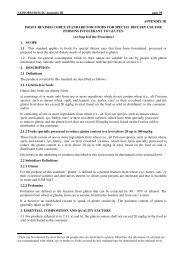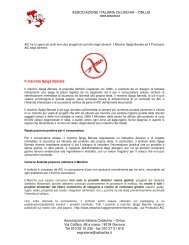primary prevention of coeliac disease - Associazione Italiana ...
primary prevention of coeliac disease - Associazione Italiana ...
primary prevention of coeliac disease - Associazione Italiana ...
Create successful ePaper yourself
Turn your PDF publications into a flip-book with our unique Google optimized e-Paper software.
THE BASIS OF COELIAC DISEASE<br />
7<br />
interactions between mesenchymal cells and epithelial cells during the migration <strong>of</strong><br />
56<br />
epithelial cells and fibroblasts from the crypts to the tips <strong>of</strong> the villi . Moreover, the<br />
tTG antibodies may modulate the deamidating activity <strong>of</strong> tTG either in an inhibiting or<br />
57<br />
promoting fashion . Further research will tell us what role these antibodies play.<br />
Translation <strong>of</strong> the new knowledge into therapy<br />
The increasing insight into the molecular and cellular basis <strong>of</strong> CD should give<br />
benefits to the patients. The knowledge on which gluten epitopes are recognized by gut<br />
T cells should allow the methods by which gluten free foods are assessed to be<br />
improved. Moreover, the new knowledge should uncover novel targets for therapy.<br />
There are already some attractive possibilities. Activation <strong>of</strong> CD4+ gluten specific T<br />
cells appears to be a critical checkpoint in the development <strong>of</strong> CD, and interference with<br />
this step in the pathogenesis should be an effective way to control the <strong>disease</strong>. One<br />
possibility, which is basically an extension <strong>of</strong> today's treatment with a gluten free diet, is<br />
to produce wheat that is devoid <strong>of</strong> T cell epitopes, either by breeding programs or<br />
transgenic technology. Success by use <strong>of</strong> classical breeding already seems unlikely as<br />
epitopes are found in both a-gliadins and g-gliadins which are encoded by the Gli-1 and<br />
Gli-2 loci located on chromosomes 1 and 6, respectively. The classical breeding<br />
approach is further complicated by the hexaploid nature <strong>of</strong> wheat. tTG is a target for<br />
intervention because <strong>of</strong> its critical role in generating gluten T cell epitopes. Inhibitors <strong>of</strong><br />
tTG activity exist and likely inhibitors suitable as drugs can be developed. The biggest<br />
problem with this approach is that tTG inhibitors may have unacceptable side effects.<br />
tTG is involved in many different physiological processes including programmed cell<br />
42<br />
death . Another strategy would be to aim at the gluten specific T cells. If <strong>coeliac</strong>s have a<br />
normal oral tolerance to native gluten proteins, but a broken tolerance to deamidated<br />
gluten peptides, exposing the gut immune system to already deamidated peptides may<br />
establish oral tolerance to these deamidated gluten peptides as well. This approach will<br />
utilize the body's own mechanism to silence T cells. Alternatively, one could try to<br />
directly silence gluten specific T cell by using soluble dimers <strong>of</strong> HLA/ peptide<br />
complexes, which have been demonstrated to induce antigen specific apoptosis<br />
58<br />
because <strong>of</strong> inappropriate T cell stimulation . The central role <strong>of</strong> DQ2 and DQ8 in<br />
presenting gluten peptides <strong>of</strong>fers yet another target for intervention. Blocking the<br />
binding-sites <strong>of</strong> these HLA molecules would prevent presentation <strong>of</strong> <strong>disease</strong> inducing<br />
gluten peptides. The challenge with this approach will be to find an efficient way to<br />
target and block the binding sites <strong>of</strong> DQ molecules, which are continuously synthesized<br />
by antigen presenting cells. This approach, blocking <strong>of</strong> peptide presentation, has also<br />
been suggested as therapy for other HLA associated <strong>disease</strong>s. CD should be better<br />
suited to this approach than many other HLA associated <strong>disease</strong>s because drug delivery<br />
in the gut is easy compared for example to joints in rheumatoid arthritis or islet cells in<br />
type 1 diabetes.<br />
Whatever new therapeutic modality is introduced in CD, it will have to prove better<br />
than the current gluten free diet regime, also when coming to its long-term safety. This<br />
fact must be taken into consideration when devising new treatments. Although there are<br />
already interesting therapeutic principles with a good, rational basis that can be tested, it<br />
may for this reason take some years before a new treatment becomes reality.


